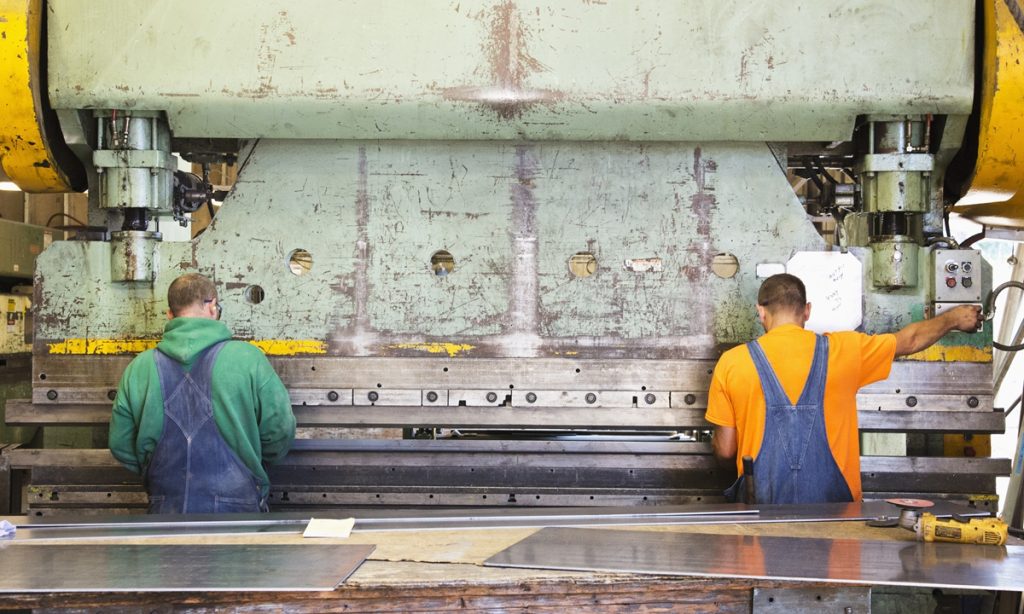GT investigates: Will ‘labor shortage’ crisis hinder the revival of US manufacturing?

Bringing manufacturing back to the US and restoring millions of jobs - this was a key economic policy championed by the Trump administration during its first term. Now, some media outlets suggest the pursuit of this goal has grown even more fervent and "obsessive." A recent article by The New York Times claimed that the US has "gambled" on launching a global trade war, assuming that imposing tariffs on foreign goods would lead to a dramatic return of factories to American soil. However, the reality is that the US currently faces a stubborn gap of 400,000 to 500,000 unfilled manufacturing jobs, presenting a major obstacle to reviving domestic production. How do Americans truly view the reshoring of manufacturing? Will labor shortages hinder this effort? The Global Times conducted interviews and investigations into these questions.
Nearly 500,000 job openings remain unfilled
The Trump administration has been upending the global economy in the name of bringing manufacturing back. But there's something rather strange undercutting this movement to reshore factory jobs: American manufacturers say they are struggling to fill the jobs they already have, National Public Radio reported on May 13.
According to data from the US Bureau of Labor Statistics, there are nearly half a million open manufacturing jobs right now. In 2024, the Manufacturing Institute, a nonprofit aimed at developing America's manufacturing workforce, and Deloitte, a consultancy firm, surveyed more than 200 manufacturing companies. More than 65 percent of the firms said recruiting and retaining workers was their No. 1 business challenge, the report said.
This is a shortfall that will surely grow if companies are forced to rely less on manufacturing overseas and build more factories in the US, The New York Times stated, citing experts as saying.
Many Americans believe increasing manufacturing jobs benefits the country but offers little personal gain - a 2024 poll by the Cato Institute found that 80 percent of respondents agreed that the US would be better off if more Americans worked in manufacturing. However, only 25 percent of those surveyed believed working in a factory would benefit them personally.
It's a result that holds across class, education, and racial lines, the Cato Institute showed. In other words, only a small fraction of Americans are willing to take factory jobs.
While Americans say they want more manufacturing back in the US, they do not believe they'd be better off working in one of them, according to the Fortune magazine. Manufacturing workers themselves report "markedly" lower personal satisfaction with their jobs than other workers, according to the Pew Research Center. "Such jobs can't find enough interested Americans to fill them," wrote Colin Grabow, associate director at Cato's Herbert A. Stiefel Center for Trade Policy Studies.
"Labor shortages in US manufacturing are indeed a pronounced issue," Zhang Tengjun, deputy director of the Department for Asia-Pacific Studies at the China Institute of International Studies, told the Global Times.
Zhang explained that the shortage stems from two key factors: First, manufacturing often requires a large workforce during peak production periods, but the US lacks enough job seekers. Second, while there are many unemployed Americans, high-tech manufacturing roles in AI, robotics, and semiconductors demand skilled and highly educated workers - qualifications that most unemployed traditional laborers from labor-intensive industries lack.
Historically, traditional manufacturing has struggled to offer strong career advancement for highly educated professionals. Yet today, many manufacturing jobs actually seek candidates with advanced education, NPR reported.
Carolyn Lee, the president and executive director of the Manufacturing Institute, says that roughly half of the open positions in manufacturing require at least a bachelor's degree. However, even in the remaining positions that don't demand a degree, manufacturers say they are also struggling to fill vacancies, NPR reported.
'Romantic picture' disconnected from reality
How do Americans view the US government's push for manufacturing reshoring? Some American scholars and citizens interviewed by the Global Times suggest that Americans today prefer less demanding jobs. "The US government's goal to bring back manufacturing jobs faces a practical challenge: A lack of interest in physically demanding work. People prefer simpler or less strenuous jobs," American citizen Ryan Kin told Global Times, noting that many Americans are now more interested in starting their own businesses or becoming influencers or celebrities on social media.
However, the Global Times learned that, unlike white-collar workers, many low-income Americans view manufacturing differently. Charlie Paglee, chairman of American Bantam Car Company, told the Global Times that many Americans are willing to work in manufacturing but lack opportunities.
He noted that about 17.5 million American workers (about 11.3 percent of the workforce) are employed in low-wage service jobs like food preparation, cashiering, or shelf-stocking, earning $13-$16 per hour, while manufacturing jobs can pay $18-$30 per hour.
"Some people want to escape low-wage jobs and enter manufacturing. Manufacturing workers take pride in producing tangible products, gaining value through skill development and building careers," Liu said.
Carl Fey, a US citizen and professor of strategy at the BI Norwegian Business School, told the Global Times that many Americans would welcome the return of manufacturing jobs and eagerly apply for them. However, signs suggest that filling all the manufacturing jobs the US government aims to create may be challenging, especially as the Trump administration seeks to reduce immigration - historically, immigrants have filled many US manufacturing roles.
Zhang Jiadong, a professor at Fudan University's Center for American Studies, told the Global Times that US industrial workers are increasingly "stereotyped," with manual manufacturing jobs primarily held by Latinos and undocumented immigrants.
Zhang Tengjun noted that Americans unwilling to work in factories are mainly less-educated white individuals who view factory jobs as low-paying, with poor working conditions and inadequate benefits, making them "not worth it." Another reality is that US manufacturing's modernization has been slow, with factories lacking the competitiveness to attract skilled workers and have low social prestige. Some undocumented immigrant workers in traditional factories also take part-time jobs in sectors like catering.
The New York Times reported that at Saitex's Los Angeles factory, most of the workers come from countries like Mexico, Guatemala and El Salvador. Steve Lamar, the chief executive of the American Apparel and Footwear Association, an industry lobby group, said there was a gap between a "romantic notion about manufacturing" and the availability of American workers.
"A lot of people say we should be making more clothing in the US, but when you ask them, they don't want to sit in the factory, nor do they want their kids to sit in the factory," he said.
How to persuade young people to enter factory?
According to the New York Times, in the US, the pool of capable and willing blue-collar workers for factory floors is shrinking. David Gitlin, chairman and CEO of Carrier Global, which produces air-conditioners and furnaces, and services heating and cooling equipment, noted, "For every 20 job postings that we have, there is one qualified applicant right now."
How can the labor shortage in US manufacturing be addressed? A report by NPR suggested that a classic solution is to offer higher pay, which might incentivize workers to acquire in-demand skills and join the manufacturing workforce. However, it's worth noting that the higher wages demanded by American manufacturing workers were among the key reasons many manufacturers left the US in the first place.
Zhang Jiadong pointed out that with current wage levels in US manufacturing already relatively high, for American products to remain competitive, factories have to move out of the US. Today, only companies in high-value-added industries like Boeing can survive in the US, he noted.
"Precisely because the US has lost its comparative advantage in the labor structure, labor-intensive industries have relocated overseas. However, after the US government politicized this issue and tried to force manufacturing back, the labor problem has been further exacerbated," Liang Huaixin, an expert in international relations from the University of International Business and Economics, told the Global Times.
Liang added that manufacturing companies returning to the US struggle to be profitable but feel compelled to comply with the government's "heavy-handed" policies, ultimately passing on costs and weakening their own competitiveness.
In the NPR report, Carolyn Lee, the president and executive director of the Manufacturing Institute, noted that solving the labor shortage is also "a PR problem." She explained that many Americans hold outdated perceptions of manufacturing jobs, imagining them as dirty, monotonous, and dangerous - like those described in Charles Dickens' novels. Thus, changing these perceptions is key to convincing more young people to enter the industry.
Gordon Hanson, an economist at the Harvard Kennedy School noted, "These jobs are in factories that are completely different from the factories of 25 years ago. They require people to know how to use pretty sophisticated machinery."
Lee also noted that the problem is that people with skills like equipment maintenance and repair are now hard to find. "Every company we speak with is trying to hire technicians. Every single one. The challenge is that there is no one walking around on the street with these skills, and it takes one to two years to teach those skills and another one to two years to contextualize those skills to the specific plant environment."
Several US officials have recently stated their intention to train a large workforce for manufacturing. In April, US Commerce Secretary Howard Lutnick told CBS that the work of "millions and millions of human beings screwing in little screws to make iPhones" would come to the United States and be automated, creating jobs for skilled trade workers such as mechanics and electricians. Treasury Secretary Scott Bessent has suggested that those who have been laid off from their jobs in the federal government will be able to take on new jobs created as tariffs rehouse manufacturing in the US, Newsweek reported
But Fortune magazine reported that economists and international trade experts are skeptical about whether this will work. Studies on the tariffs imposed during Trump's first term found they did not bring jobs to protected industries.
Liang pointed out that from the US government's perspective, there is no better solution than following the objective laws of economic development. "This means embracing an open, cooperative approach to changes in global trade, focusing on enhancing America's specific comparative advantages in the global value chain, and upgrading workers' specialized skills - rather than pressuring other countries or multinational corporations, which would likely backfire," he said.

